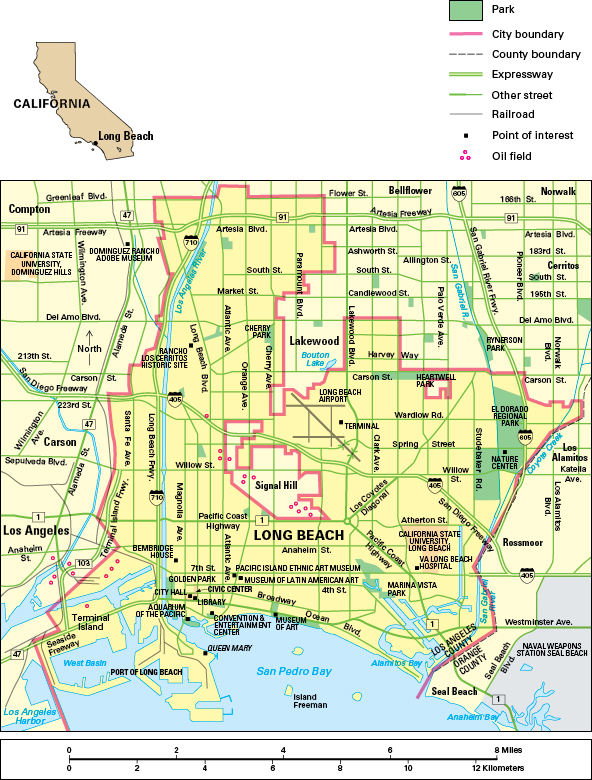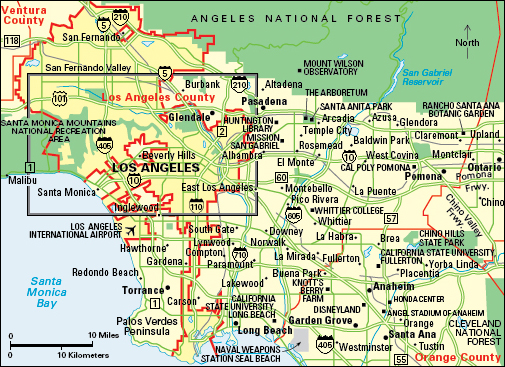Long Beach (pop. 466,742) is a major industrial center and seaport in southern California, near Los Angeles. Long Beach, Los Angeles, and Anaheim form part of a metropolitan area that has a population of 13,200,998. Long Beach lies along San Pedro Bay, 20 miles (32 kilometers) southeast of Los Angeles.
Description.
Long Beach covers 51 square miles (132 square kilometers) of land. The city has 7 miles (11 kilometers) of beaches. It is the home of California State University, Long Beach. The Long Beach Convention & Entertainment Center includes exhibit halls, theaters, and an arena.
Economy.
Leading industries in Long Beach include electronics manufacturing, food processing, and oil production. The city is the site of the Wilmington Oil Field, which has produced several billion barrels of oil since its discovery in 1936. Much of the oil is pumped from offshore oil wells. Income from the oil wells goes mostly to the state. However, the city government receives a share of the oil revenue. The Port of Long Beach is one of the busiest ports in the United States.

Long Beach is a leading health care center. The city has a number of major private hospitals. It also has one of the largest of the hospitals operated by the United States Department of Veterans Affairs.
Long Beach is also a tourist center. Its attractions include the Aquarium of the Pacific and the ocean liner Queen Mary, which is permanently docked there.
History.
Shoshone Indians lived in what is now the Long Beach area before white settlers arrived there. The area consisted chiefly of ranchland until the mid-1880’s, when railroads linked the Midwest and southern California. The railroads brought thousands of settlers there, and a group of land investors founded Long Beach in 1888. The town was incorporated as a city in 1897, when it had a population of about 1,700.

Long Beach developed as a resort city because of its beaches and warm climate. In 1921, oil was found in Signal Hill, now a small city surrounded by Long Beach. The discovery drew so many people to the area that the population of Long Beach rose from 55,593 in 1920 to 142,032 in 1930. On March 10, 1933, an earthquake in the city killed 52 people and damaged property worth over $40 million.
The Wilmington Oil Field was discovered in 1936. The aircraft industry developed in Long Beach during World War II (1939-1945). The city’s population increased from 164,271 in 1940 to 250,767 in 1950, largely because of industrial growth.
During the 1940’s, areas of land near the Long Beach harbor began to sink because so much oil had been removed from the ground. In 1958, the city began to pump water into the ground. The resulting water pressure has prevented further sinkage.
A number of new buildings were constructed in Long Beach in the 1980’s and 1990’s as part of a major redevelopment of the downtown area. A civic center that features city, county, and state offices was built. Commercial and residential structures, high-rise office buildings, hotels, and a shopping mall also were completed. The population of Long Beach continued to grow rapidly, rising from 361,355 in 1980 to 466,742 in 2020. In 1997, the Long Beach Naval Station, which had been established in 1942, was closed. Long Beach has a council-manager form of government.
